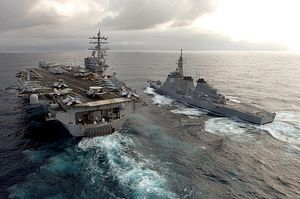While 26 countries, 45 ships, five submarines, and 25,000 personnel take part in this year’s Rim of the Pacific (RIMPAC) military exercises in waters off Hawaii and southern California, far across the Pacific, along the western coast of Japan, summer festivals herald the beginning of the fishing season. Fisherman going after squid in the Yamato shallows near Japan’s northwestern coast are especially concerned this season about confrontation with North Korean fisherman, who have been coming closer in recent years. Much of the squid fishing occurs at night and with the small, rickety wooden boats used by North Korean fisherman, it increases the risk of an unintentional collision that may have larger ramifications.
The Japanese Coast Guard has been called upon to play a larger role in defending Japan’s fishing areas, including the exclusive economic zone near the Yamato shallows. On June 1, the coast guard announced that it was increasing patrols in the area to warn off North Korean fishing boats; it has warned 112 boats to leave the area since last month, according to a Japanese Coast Guard spokesman in a recent Japan Times article. When fishing season peaks, dozens of boats are spotted each day. The coast guard has taken on additional patrols in order to defend the squid fishing grounds. Squid is an important part of the Japanese summer diet, especially in the Hokuriku region.
The problem that fisherman face in the Yamato shallows is just one example of the way in which Japan’s access to its fishing areas has been constrained as of late. During the summer fishing season tensions increase in the waters on Japan’s coastline and in the Pacific. Clashes with Chinese fisherman in the East China Sea highlight what some have called Japan’s reactionary stance with regard to incursions by Chinese and Korean fisherman in its coastal waters.
Japan was late to develop a strategy with regard to protecting its maritime territory. The Ocean Enclosure Movement that emerged after the United Nations Convention of the Law of the Sea (UNCLOS) was ratified in 1996 prompted many states to assert their maritime rights. For example, China enacted its own Exclusive Economic Zone (EEZ) laws and began drilling in the East China Sea in the late 1990s. Japan enacted its Basic Ocean Law in 2007 and created a new Cabinet level position to deal with maritime issues a decade after many of its neighbors had already created their own laws and institutions to support them.
Given North Korea’s current economic situation, its fisherman may be more likely to take higher risks. The country is in the midst of a food crisis; the UN Food and Agriculture Organization estimates that 88 percent of North Korea’s population suffers from a dietary energy supply inadequacy. Drought, a decline in production, hunger, and increased sanctions against the regime announced by U.S. President Donald Trump back in February have had dire consequences for North Korea’s citizens, many of whom face starvation. These conditions are likely to prompt fisherman to travel farther than before to access prime fishing territory, which will bring them into conflict with Japanese fishermen.
The conflict with fishermen in the Yamato shallows and clashes with Chinese and Taiwanese fisherman in the East China Sea come alongside the Japanese government’s push to increase their naval capabilities. Last year, Tokyo re-outfitted the vessel Myoko (a ship on the lookout for North Korean missile launches) with Aegis, a United States military technology allowing for ballistic missile detection. The government recently announced plans to proceed with the purchase of additional Aegis systems that it aims to deploy as early as 2023. The Aegis Ashore systems are long-range missile detection radar systems that will be used to protect Japan against China and North Korea. The purchase comes in advance of the release of the defense budget proposal’s release in August.
Japan is playing a key role in this year’s RIMPAC games, showing off the very capable abilities of the Maritime Self-Defense Forces, which work seamlessly with the United States Navy. This year, the exercise features the firing of a surface-to-ship missile by Japan’s Ground Self Defense Force, and Japan Maritime Self-Defense Force Rear Adm. Hideyuki Oban is serving as vice commander for the Combined Task Force (the third highest position in the games). Japan’s leadership in the games, combined with the stepping up of its military capabilities, though currently only defensive, are a likely precursor to offensive strengthening as well. China’s reaction to these moves by Japan hangs in an unsteady balance while the heat of summer takes hold.
Nicole L. Freiner is Associate Professor of Political Science at Bryant University.

































